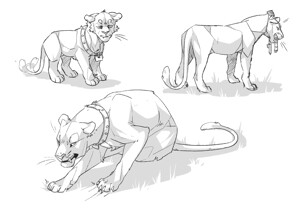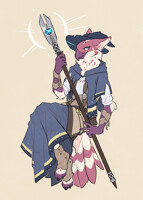Views: 968
Submissions: 34
Favs: 19

They/Them | Fae/Faer | Registered: March 26, 2021 12:33:12 PM
❤❤❤❤❤❤
❤❤❤❤ Ashe | They/Them | US | Hobby Artist ❤❤❤❤❤
Hello, I'm Ashe the Harrel. I occasionally draw. Since I got my Huion Kamvas 13 tablet, I draw a bit more :)
Discord: the_paras
Deviant Art: aorsak
FB Page: Art by A Harrel Featured Submission
Recent Watchers
Recently Watched
Stats
Comments Earned: 10
Comments Made: 8
Journals: 1
Comments Made: 8
Journals: 1
Recent Journal
Harrels - An Original Species
4 years ago
Harrels are a unique species which falls under the clade Glire, which contains the orders Lagomorpha (Lagomorphs: Rabbits, Hares, Pikas) and Rodentia (Rodents: Mice, Rats, Etc.). This is where I've interjected a new order: Jaculumorpha. Listed below is a more specific list of the rest. I suppose technically I've created an "Original Genus" as opposed to a species.
Kingdom: Animalia
Phylum: Chordata
Class: Mammalia
(Unranked) Clade: Glires
Order: Jaculumorpha
Family: Cervisciuridae
Genus: Cornatus
Species: canadensis, orientalis, and pygmaeus
Before getting into specifics about each species, I'd like to mention some universal characteristics.
Harrels have 3 sexes. ZZ, ZW, and WW. Male, intersex, and female. Two males or two females cannot produce offspring on their own, but it is very common for them to foster kits from other litters, as harrels always live in groups. It is not uncommon for more than 2 harrels to raise a litter. All harrels can lactate, and are induced lactators. Meaning their milk supply is on demand. They are relatively flat chested, but have 8 nipples roughly following the human milk line. (Can be seen on Maryama Ahmar) Harrel nipples may not always be visible though, as they are easily hidden by fur, but tend to be more prominent on the Tawny Desert Harrels with very short fur. They are more easily seen on nursing harrels in general.
A male and an intersex harrel (ZZ x ZW) can only produce male and intersex offspring. A female and an intersex harrel (ZW x WW) can only produce female and intersex offspring. A male and a female (ZZ x WW) will produce only intersex offspring. Two intersex harrels (ZW x ZW) can produce male, female, and intersex offspring. All harrels can interbreed, but issues will likely arise if the gestating harrel is smaller than the harrel that provided sperm.
Harrels are similar to cats, in that they can carry offspring from multiple different other harrels. If a female or intersex harrel copulates with several other intersex or male harrels, the litter may be larger and more diverse. Harrel litters range from 2-6 and are born hairless, hornless, and featherless. Their eyes and ears are closed, and they cannot stand. They must remain with a harrel at all times for heat or stay in a well insulated nest until they grow fur. Harrels often build nests in trees, caves, or burrows depending on the species.
Harrels have a very loose concept of gender, if any at all. White-tailed and pygmy harrels generally do not have gender, and live in egalitarian or colony style groups. (Colony referring to animals, not colonialism) Tawny desert harrels live in a harsher environment, and require more leadership for survival. They tend to be matriarchal as female TD harrels are usually the largest of the 3 sexes for this species, followed by intersex harrels, and then males. Depending on the world setting, harrels may or may not speak a language, but all use sign language. Their language regarding the 3 sexes is "werfae, wyxfae, and wiffae" for males, intersex, and females respectively. Harrels have very little, if any, sexual trimorphism. This means that they do not look different based on sex.
Colors are based on mouse colors. Hopefully I can get some color pallets posted soon, so it makes more sense.
White-Tailed Harrel
Cornatus canadensis
-Large hind paws and dense fur to protect them from frigid temperatures.
-Soft, polite, quiet creatures. Easily startled, quick to trust, and often affectionate. Very Curious.
-Semi-terrestrial, chionophile, egalitarian, medium intellect
-Soft light to medium greys/blues are common. White, dark grey/blue, and siamese are uncommon. Black and albino are extremely rare. All colors (except albino) have black ear lacing. Eyes black, but siamese is ruby. Lacing on wings is extremely common. Fur is ticked, except for black and albino.
-Horns are shaped like those of young white-tailed deer.
-Average height ranges from 3 to 3.5 ft tall. (90-105 cm~)
-This species prefers sign language over sylvan/vocalizations.
Tawny Desert Harrel
Cornatus orientalis
-Medium sized feet built for sand and rock with short slick fur.
-Slow to trust, but fiercely loyal once they have. Easily alerted to danger, yet loud and rambunctious when they feel safe. Territorial, but not necessarily aggressive.
-Terrestrial, xerophile, matriarchal, high intellect
-Medium beige and dark rufous reds are most common. Chocolate, champagne and cream are uncommon. Black is rare. Striping/brindling across the lower back, arms, and thighs is common. Eyes black or brown. Fur is self.
-Horns are like those of springbok.
-Average height 3.5 to 4 feet tall. (105-120 cm~)
-This species uses sign language and sylvan/vocalizations equally.
Pygmy Harrel
Cornatus pygmaeus
-Regular sized feet with slightly larger claws for digging, or fighting. Medium-short length fur with average density.
-Very difficult to gain trust. Often rude and aggressive. Will yell at you in Sylvan/vocalizations. Commonly fights another animals their size, and sometimes larger, in a pack. Territorial: will use their horns to stab you and their disproportional canines to bite you. Very animalistic and most do not immediately realize they are indeed sentient.
-Fossorial, colony, low intellect
-Agouti and white bellied agouti are common. Cinnamon, lynx, blue agouti, and agouti tan are uncommon. Black tan and albino are rare. Eyes black or brown, but albino pink. Usually ticked.
-Horns are shaped like those of goats.
-Average height 1.5 to 2 feet. (45-60 cm~)
-This species uses Sylvan/vocalizations often, but will use sign language when necessary.
Kingdom: Animalia
Phylum: Chordata
Class: Mammalia
(Unranked) Clade: Glires
Order: Jaculumorpha
Family: Cervisciuridae
Genus: Cornatus
Species: canadensis, orientalis, and pygmaeus
Before getting into specifics about each species, I'd like to mention some universal characteristics.
Harrels have 3 sexes. ZZ, ZW, and WW. Male, intersex, and female. Two males or two females cannot produce offspring on their own, but it is very common for them to foster kits from other litters, as harrels always live in groups. It is not uncommon for more than 2 harrels to raise a litter. All harrels can lactate, and are induced lactators. Meaning their milk supply is on demand. They are relatively flat chested, but have 8 nipples roughly following the human milk line. (Can be seen on Maryama Ahmar) Harrel nipples may not always be visible though, as they are easily hidden by fur, but tend to be more prominent on the Tawny Desert Harrels with very short fur. They are more easily seen on nursing harrels in general.
A male and an intersex harrel (ZZ x ZW) can only produce male and intersex offspring. A female and an intersex harrel (ZW x WW) can only produce female and intersex offspring. A male and a female (ZZ x WW) will produce only intersex offspring. Two intersex harrels (ZW x ZW) can produce male, female, and intersex offspring. All harrels can interbreed, but issues will likely arise if the gestating harrel is smaller than the harrel that provided sperm.
Harrels are similar to cats, in that they can carry offspring from multiple different other harrels. If a female or intersex harrel copulates with several other intersex or male harrels, the litter may be larger and more diverse. Harrel litters range from 2-6 and are born hairless, hornless, and featherless. Their eyes and ears are closed, and they cannot stand. They must remain with a harrel at all times for heat or stay in a well insulated nest until they grow fur. Harrels often build nests in trees, caves, or burrows depending on the species.
Harrels have a very loose concept of gender, if any at all. White-tailed and pygmy harrels generally do not have gender, and live in egalitarian or colony style groups. (Colony referring to animals, not colonialism) Tawny desert harrels live in a harsher environment, and require more leadership for survival. They tend to be matriarchal as female TD harrels are usually the largest of the 3 sexes for this species, followed by intersex harrels, and then males. Depending on the world setting, harrels may or may not speak a language, but all use sign language. Their language regarding the 3 sexes is "werfae, wyxfae, and wiffae" for males, intersex, and females respectively. Harrels have very little, if any, sexual trimorphism. This means that they do not look different based on sex.
Colors are based on mouse colors. Hopefully I can get some color pallets posted soon, so it makes more sense.
White-Tailed Harrel
Cornatus canadensis
-Large hind paws and dense fur to protect them from frigid temperatures.
-Soft, polite, quiet creatures. Easily startled, quick to trust, and often affectionate. Very Curious.
-Semi-terrestrial, chionophile, egalitarian, medium intellect
-Soft light to medium greys/blues are common. White, dark grey/blue, and siamese are uncommon. Black and albino are extremely rare. All colors (except albino) have black ear lacing. Eyes black, but siamese is ruby. Lacing on wings is extremely common. Fur is ticked, except for black and albino.
-Horns are shaped like those of young white-tailed deer.
-Average height ranges from 3 to 3.5 ft tall. (90-105 cm~)
-This species prefers sign language over sylvan/vocalizations.
Tawny Desert Harrel
Cornatus orientalis
-Medium sized feet built for sand and rock with short slick fur.
-Slow to trust, but fiercely loyal once they have. Easily alerted to danger, yet loud and rambunctious when they feel safe. Territorial, but not necessarily aggressive.
-Terrestrial, xerophile, matriarchal, high intellect
-Medium beige and dark rufous reds are most common. Chocolate, champagne and cream are uncommon. Black is rare. Striping/brindling across the lower back, arms, and thighs is common. Eyes black or brown. Fur is self.
-Horns are like those of springbok.
-Average height 3.5 to 4 feet tall. (105-120 cm~)
-This species uses sign language and sylvan/vocalizations equally.
Pygmy Harrel
Cornatus pygmaeus
-Regular sized feet with slightly larger claws for digging, or fighting. Medium-short length fur with average density.
-Very difficult to gain trust. Often rude and aggressive. Will yell at you in Sylvan/vocalizations. Commonly fights another animals their size, and sometimes larger, in a pack. Territorial: will use their horns to stab you and their disproportional canines to bite you. Very animalistic and most do not immediately realize they are indeed sentient.
-Fossorial, colony, low intellect
-Agouti and white bellied agouti are common. Cinnamon, lynx, blue agouti, and agouti tan are uncommon. Black tan and albino are rare. Eyes black or brown, but albino pink. Usually ticked.
-Horns are shaped like those of goats.
-Average height 1.5 to 2 feet. (45-60 cm~)
-This species uses Sylvan/vocalizations often, but will use sign language when necessary.
User Profile
Accepting Trades
No Accepting Commissions
No Character Species
Harrel
Favorite Music
Alternative Rock/Pop
Favorite TV Shows & Movies
Arrival, Wolf Children
Favorite Games
D&D, StoneHearth
Favorite Gaming Platforms
PC
Favorite Animals
Canada Lynx, House Mice
Favorite Site
FaceBook (for animal stuff)
Favorite Foods & Drinks
Dr Pepper
Contact Information







Kaijupuppy
~ianto

 FA+
FA+









































